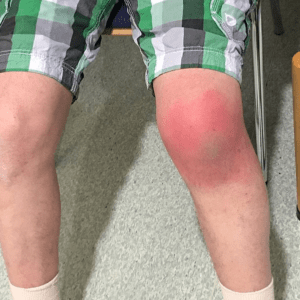25 years old man presented to A&E with h/o acutely painful erythematous left knee joint. There was no h/o trauma. He was working as a cleaner. He had no previous medical problems and did not take any regular medication. On examination he was apyrexial and vitals were within normal limits.
How can we differentiate pretibial bursitis from septic arthritis?
My learning:
Prepatellar bursa is present between the patella and the overlying subcutaneous tissue. It represents the most commonly affected bursae of the knee and the second most commonly affected bursa overall, following the olecranon bursa. [1]
The location makes it a target during repetitive kneeling and has led to it being colloquially referred to as housemaids, carpet layers, and carpenters knee.
Trauma or puncture of skin at the site of a bursa can lead to the direct introduction of bacteria and subsequent inflammation and infection.
In pre patellar bursitis swelling and inflammation is localised to the bursa (overlying the patella). Joint effusion is absent and range of motion of joint is normal whereas septic arthritis patients present with pain, joint swelling and inability to move the affected joint.
The most common risk factor for septic arthritis is pre existing joint disease. Other risk factors include hematogenous spread (e.g., injection drug use), direct inoculation (e.g., trauma or recent procedure), or contiguous spread (e.g., abscess).
In a narrative review of literature [2] which included 133 articles, the manifestation of various symptoms in septic arthritis are as follows:
The most common symptom is joint pain, which is found in 85% of patients.
Joint swelling occurs in 78% of cases
joint tenderness has been suggested to be 100% sensitive.
Fever ≥ 39oC occurs in up to 58% of patients, and up to 90% of patients have been shown to have a low-grade fever (≥ 37.5oC). The absence of fever should not be relied upon to exclude septic arthritis.
A joint with painful and limited active and passive range of motion is suggestive of intra-articular infection.
Serum blood tests are inadequate to rule out septic arthritis. Synovial fluid analysis is the gold standard test for making the diagnosis of septic arthritis.
A synovial white blood cell count (sWBC) ≥ 50 × 109/L is concerning for septic arthritis.[3,4]
Bottom line:
Septic arthritis is a potentially serious condition that unfortunately does not always present classically. The red, hot, swollen joint mandates consideration of septic arthritis.
No physical examination finding can rule out the condition, and serum blood tests should not be used to exclude septic arthritis. Joint aspiration and analysis of synovial fluid is the gold standard for diagnosis.
References:
1.Rishor-Olney CR, Pozun A. Prepatellar Bursitis. 2021 Jun 5. In: StatPearls [Internet]. Treasure Island (FL): StatPearls Publishing; 2021 Jan–. PMID: 32491440.
2 .Long B, Koyfman A, Gottlieb M. Evaluation and Management of Septic Arthritis and its Mimics in the Emergency Department. West J Emerg Med. 2019;20(2):331-341. doi:10.5811/westjem.2018.10.40974
- Carpenter CR, Schuur JD, Everett WW, et al. Evidence-based diagnostics: adult septic arthritis. Acad Emerg Med. 2011;18(8):781–96.
- Margaretten ME, Kohlwes J, Moore D. Does this adult patient have septic arthritis? JAMA. 2007;297(13):1478–88

